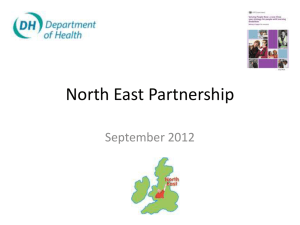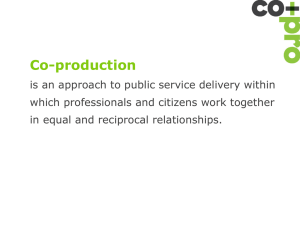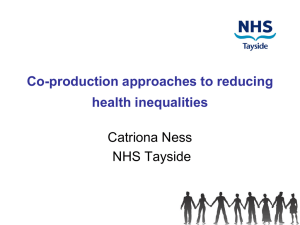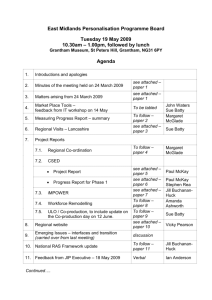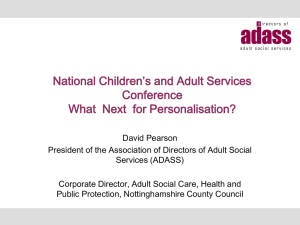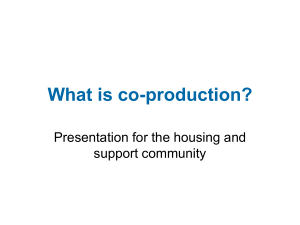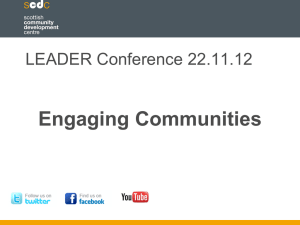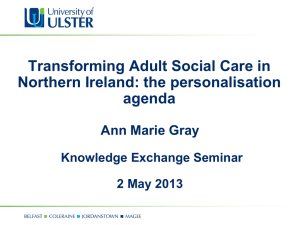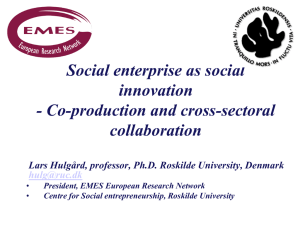Jerry Tew - Family Potential
advertisement
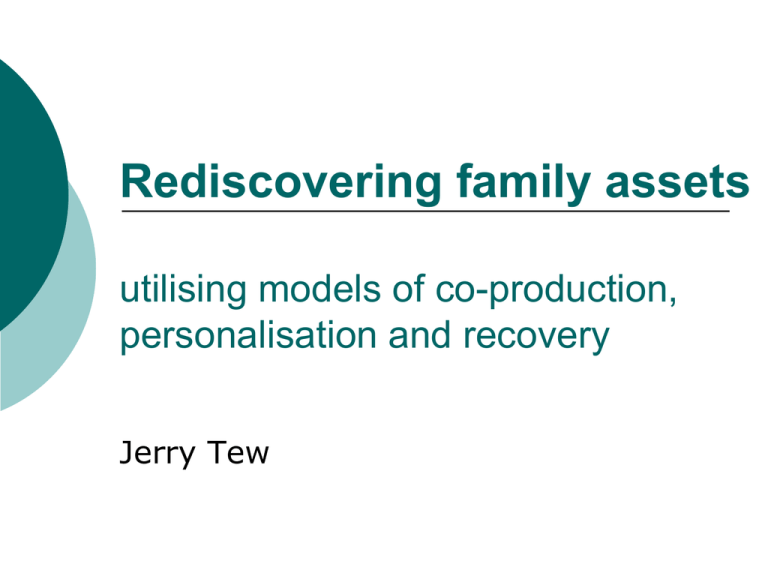
Rediscovering family assets utilising models of co-production, personalisation and recovery Jerry Tew Tentative new paradigm for ‘welfare’ Shift from a paternalistic deficit-based model of ‘doing to’ service provision to more of a ‘shared ownership’ model which focuses on what people can (potentially) do, and the resources they may be able to access, in conjunction with others Emerging in wider policy discourse in public services, and particularly in relation to adult social care and health and wellbeing - but not always very clearly articulated Drivers: a) Pressure from user and carer groups to be able to do what works best for them b) Current system for providing social care is unaffordable c) Local Authorities taking on responsibilities for public health and wellbeing Inhibitors: Statutory focus on ‘risk’ and ‘need’ Short-sighted approach to resource rationing: eligibility based on current level of deficit / risk, not on potential outcomes Marketisation of services Top-down managerialism Theorising ‘positives’: some overlapping terms Assets Capabilities Capitals Assets approach – looking for ‘can do’ rather than ‘can’t do’ Knowledge and abilities Resources (including time) Access to opportunities Relationships, trust and reciprocity Enthusiasm, motivation and positive thinking Potential Seen as key to promoting wellbeing (Foot, 2012). Links to strengths approach in social work Assets approach Internalised assets Relational assets Access to resources / opportunities Assets approach Has tended to be applied at individual or community levels (Morgan and Ziglio, 2007) Little explicit engagement with ‘family’ – but ‘family’ may represent an intermediate level of context where an assets approach may be particularly effective in mobilising potential and bringing about different outcomes. Some current asset-based models for policy and practice Co-production Personalisation Recovery Co-production Situates people not as passive consumers of (marketised) services, but as active asset-holders in the collaborative development of resources and solutions (Needham and Carr, 2009) utilising assets such as local / personal knowledge, time, access to resources and social connectivity in order to produce some combination of private value for individuals and / or public value for groups and communities Co-production Emphasis on ‘relational’ rather than ‘transactional’ approaches to service delivery Frontline staff as catalysts / enablers rather than as gatekeepers for over-stretched services Relocation of power and control from organisational hierarchies to citizens and frontline staff Focus on outcomes – enhanced capitals and capabilities, not just problems solved or risks managed Co-production and families Families as neglected ‘layer’ in much of the literature which tends to focus on either individuals or communities Families may have greater potential to be co-productive than individuals (more assets, especially relational assets) Families may also be the site of oppressive processes that limit deployment of specific forms of capital. Personalisation (Putting People First) Broad capability-based vision for adult social care: 1. access to mainstream (education, employment, leisure) 2. prevention / early intervention : provision of more intensive resource when most productive 3. choice and control – personal budgets 4. social capital. Service user as co-producer / asset-holder Personalisation in practice With notable exceptions... Focus on personal budgets rather than broader asset-building agenda Individualised rather than collective solutions Resource Allocation System (restriction to ‘critical’) diverting resources to reactive purchase of ‘dependence-inducing’ care services rather than strategic building of longer term capability Confused approach to role of family However... Some localities have managed to use personal budgets as a mechanism to shift resources into asset-building approaches (e.g. working with user-led organisations) – but hard to use current resource allocation systems to support asset-building at family level Community Budget initiatives may open up mechanisms for more effective family-based approach – but how do we join this up with personal health and social care budgets? Recovery (mental health) Idea rooted in user/survivor movement people taking back power for themselves in order to ‘get a life’ – irrespective of any ongoing mental health difficulties. Recovery can involve 1. (Re)discovering a positive sense of self and hope for the future 2. Finding a way of understanding that gives meaning to (or control over) one’s experiences 3. Dealing with personal, social or relationship issues that may contribute to one’s difficulties 4. Taking on satisfying and meaningful social roles within mainstream society 5. Having strategies for managing particular situations, experiences or behaviours that cause difficulty or distress 6. Being able to call upon formal and / or informal systems of support as needed (Tew, 2011) What makes a difference in enabling recovery? Having opportunities to reclaim power and control over one’s life Supportive relationships that allow for reciprocity Social inclusion and acceptance (places and activities) Opportunities to rebuild positive personal and social identities (Tew et al, 2012) What gets in the way of recovery? ‘Them and us’ thinking and practices Disproportionate focus on risk and dangerousness Services that construct people as passive ‘patients’ that require treatment by ‘experts’ Stigmatisation within services and wider community Implicit messages of hopelessness Wider implications Much of idea and practice of recovery is applicable outside mental health It is potentially applicable to ‘troubled’ families as well as ‘troubled’ individuals To conclude: an assets approach to engaging with families Requires: A fundamental shift of perception, analysis and practice Looking for capabilities and capitals – actual and potential Adopting a relational (doing with / facilitating / catalysing) rather than a transactional (doing to) approach Building on and adapting models so that they can work at the scale of the family (e.g. personalisation, recovery) Organisational culture change Key questions for discussion 1. What might assets thinking have to offer in different areas of policy and practice with families? How transferable are ideas such as co-production, personalisation and recovery? How well might these work at the level of ‘whole family’ contexts and practices? 2. What may be dangers or limitations of going down this route? 3. Where it may be a good idea, what could be the barriers to implementing assets-based approaches? 4. Cultural Organisational Other How might we overcome these? References Bourdieu, P (1986) The forms of capital. In J.Richardson (ed) Handbook of theory and research for the sociology of education. New York: Greenwood Press. Department of Health (2007) Putting people first: a shared vision and commitment to the transformation of adult social care. London: Department of Health Foot, J (2012) What makes us healthy? The asset approach in practice http://www.janefoot.co.uk/downloads/files/healthy%20FINAL% 20FINAL.pdf Morgan A and Ziglio E (2007) Revitalising the evidence base for public health: an assets model, Promotion and Education Supplement 2 pp17-22 Needham, C and Carr, S (2009) Co-production: an emerging evidence base for adult social care transformation. SCIE Research briefing 31. Sen, A. (1993). Capability and Well-Being. In M. Nussbaum and A. Sen, eds. The Quality of Life, pp. 30–53. New York: Oxford Clarendon Press. Schuller, T, Bynner, J and Feinstein, L (2004) Capitals and capabilities. London: Centre for Research on the Wider Benefits of Learning. Tew, J (2011) Social approaches to mental distress. Basingstoke: Palgrave Macmillan Tew, J (2012) Recovery capital: what enables a sustainable recovery from mental health difficulties? European Journal of Social Work DOI:10.1080/13691457.2012.687713 Tew, J et al, (2012) Social factors and recovery from mental health difficulties: a review of the evidence. British Journal of Social Work 42(3): 443-460 White, W and Cloud, W (2008) Recovery capital: a primer for addictions professionals. Counsellor 9(5):22-27
![Transformational Change [Powerpoint Presentation]](http://s2.studylib.net/store/data/005447411_1-da0a83bd34bdb90183940ab700125003-300x300.png)
